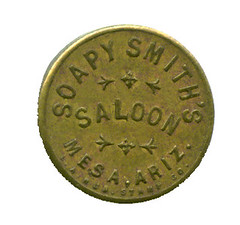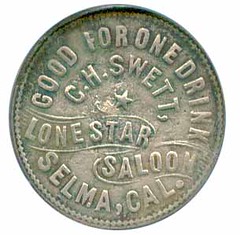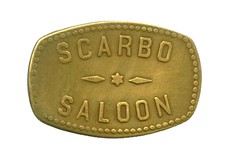
PREV ARTICLE
NEXT ARTICLE
FULL ISSUE
PREV FULL ISSUE
NEW BOOK: COLLECTING GUIDE TO THE PIONEER MINOR COINAGE OF AMERICAN SALOONS With permission from author Fred Holabird, the following excerpts are from his upcoming book, Collecting Guide to the Pioneer Minor Coinage of American Saloons -Editor  The idea for this collecting guide was born of the Holabird Americana pioneer minor coinage auctions that were so successful over the past two decades. Collectors constantly asked questions about rarity, availability and stories. The Collecting Guide is the result of these questions. It is intended to introduce saloon token collecting to all audiences, and make it fun in the process. The idea for this collecting guide was born of the Holabird Americana pioneer minor coinage auctions that were so successful over the past two decades. Collectors constantly asked questions about rarity, availability and stories. The Collecting Guide is the result of these questions. It is intended to introduce saloon token collecting to all audiences, and make it fun in the process. The text in this guide is markedly different from other works. Our goal was fun stories from each state. Along the way we realized that different states had different alcohol laws that directly relate to token rarity. We spent the better part of two and a half years acquiring and researching these wonderful coins. This book is the compilation of a massive effort on the part of the entire Holabird-Kagin Americana staff.  Saloons are as much a fixture of the American West as cowboys, Indians and six-shooters. Saloon tokens are some of the most sought-after tokens or coins by collectors today. They have existed for a millennia and once included many types of businesses such as coffee houses, restaurants, ice cream parlors, road houses, bars, taverns, billiard halls, and brothels. Saloons are as much a fixture of the American West as cowboys, Indians and six-shooters. Saloon tokens are some of the most sought-after tokens or coins by collectors today. They have existed for a millennia and once included many types of businesses such as coffee houses, restaurants, ice cream parlors, road houses, bars, taverns, billiard halls, and brothels.This book primarily deals with the pioneer minor coinage associated with the pre-Prohibition saloon. Merchants used “tokens,” a form of money or pioneer minor coinage as both change and advertising. The majority of American saloon tokens got their start during the Civil War, primarily from coffee house-type saloons. In the west, the use of the saloon token took off in the 1870s and was in wide usage by the late 1890s. From Roughing It! By Mark Twain: In Nevada, for a time, the lawyer, the editor, the banker, the chief desperado, the chief gambler, and the saloon keeper occupied the same level of society, and it was the highest. The cheapest and easiest way to become an influential man and be looked up to by the community at large was to stand behind a bar, wear a cluster-diamond pin, and sell whiskey. I am not sure but that the saloonkeeper held a higher rank than any other member in society. His opinion had weight. It was a privilege to say how the elections should go. No great movement could succeed without the countenance and direction of the saloonkeeper.  One popular category for saloon token collecting is the pre-1900 group, though these are harder to find (and verify). Many pre-1900 saloons advertised their saloons through the use of billiard manufacturers, who provided tokens with the merchant names on the obverse and the billiard manufacturer on the reverse, usually with a picture or vignette of a pool table. Most of the pool and billiard tables were manufactured in Chicago. Die sinkers there made tokens for many of the table manufacturers, and some of these are thought to have had an office in San Francisco to help facilitate the western saloon and pool table/billiard business. One popular category for saloon token collecting is the pre-1900 group, though these are harder to find (and verify). Many pre-1900 saloons advertised their saloons through the use of billiard manufacturers, who provided tokens with the merchant names on the obverse and the billiard manufacturer on the reverse, usually with a picture or vignette of a pool table. Most of the pool and billiard tables were manufactured in Chicago. Die sinkers there made tokens for many of the table manufacturers, and some of these are thought to have had an office in San Francisco to help facilitate the western saloon and pool table/billiard business.Wayne Homren, Editor The Numismatic Bibliomania Society is a non-profit organization promoting numismatic literature. See our web site at coinbooks.org. To submit items for publication in The E-Sylum, write to the Editor at this address: whomren@gmail.com To subscribe go to: https://my.binhost.com/lists/listinfo/esylum All Rights Reserved. NBS Home Page Contact the NBS webmaster 
|